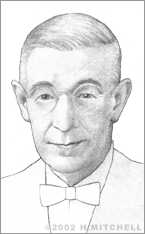Vannevar Bush
Vannevar Bush, the inventor credited with the principles underlying modern hypertext research, was born on March 11, 1890 in Everett, Massachusetts. He was a headstrong child who showed an early aptitude for math. After graduating high school, he enrolled at Tufts University in Massachusetts to study engineering. While he was there, he came up with his first invention, a land surveying device he called a “profile tracer.” The device resembled a lawnmower and as it was pushed over land, it automatically calculated elevations and drew a crude map. The machine never caught on commercially, but it did teach Bush that in order for an invention to become successful, the inventor had to be somewhat of a politician as well.
Bush earned his BS and MS from Tufts in 1913 and worked for the General Electric test department. After briefly teaching mathematics at his alma mater and working for U.S. Navy Inspections, he earned doctoral degrees in engineering, awarded by both Harvard University and Massachusetts Institute of Technology (MIT). He married and served as an assistant professor of electrical engineering at Tufts until 1919, when he returned to MIT as a professor of electrical power transmission. Through the next decade, he stayed at MIT while he worked on submarine detection for the U.S. Navy (during World War I) and created the "network analyzer," a system for setting up miniature versions of large electrical networks. He and his MIT team also developed a prototype of the "differential analyzer," which Bush patented in 1935. The device, which provided solutions to differential equations, was used in World War II to calculate the ballistics table. In 1932, Bush was appointed Vice President of MIT and Dean of the School of Engineering.
In 1938, Bush was elected president of the Carnegie Institution. The position afforded him a highly visible platform for him to help influence the United States’ scientific policy and strategy. At that time, the nation was about to enter World War II and was ill-prepared. On June 12, 1940, Bush met with President Franklin D. Roosevelt to present his plan for mobilizing military research. He proposed a new organization he called the National Defense Research Committee (NDRC). The president approved the plan, and Bush was appointed Chairman of the NDRC while retaining his position at the Carnegie Institution. Soon after, the NDRC was subsumed into the newly created Office of Scientific Research and Development. From 1941 to 1947, Bush served as Director of the OSRD.

In 1944, Bush submitted "Science, the Endless Frontier” to President Roosevelt, and the ideas put forth in this proposal led to the establishment of the National Science Foundation in 1950. At that time, Bush was also focused on developing machines for automating human thinking. His idea for a “rapid selector” would store huge amounts of information on microfilm and enable a user to quickly select documents that could then be projected on screen. It was one of the first attempts by anyone to create a personal information processor.
In 1945, Bush authored the article “As We May Think” in the Atlantic Monthly in which he first proposed his idea of the Memex machine. This machine was designed to help people sort through the enormous amount of published information available throughout the world. His article described a Memex as a “device in which an individual stores his books, records, and communications and which is mechanized so that it may be consulted with exceeding speed and flexibility. It is an enlarged intimate supplement to his memory.”
This description, which was written about 30 years before the invention of the personal computer and 50 years before the birth of the public World Wide Web, lays out the notion of the modern link. The Memex was to be a storage and retrieval device using microfilm that would consist of a desk with viewing screens, a keyboard, selection buttons and levers, and microfilm storage. The machine would augment human memory by allowing the user to make links, or “associative trails,” between documents. Bush proposed the notion of blocks of text joined by links and introduced the terms "links," "linkages," "trails," and "Web" through his descriptions of a new type of textuality. Bush’s article greatly influenced the creators of what we know as “hypertext” and how we use the Internet today. (Ted Nelson coined the term “hypertext” in 1967).
During the course of his inventing career, Bush also created the “Cyclops Camera,” which would be worn on the forehead using instantly-developable film, a mathematical calculator, improvements to microfilm, and a “vocoder,” or voice-activated typing machine. He served on the boards of several major companies, such as AT&T, and continued to work with the military, federal government, and educational institutions throughout his lifetime. In 1946, he was appointed Chairman of the Joint Research and Development Board of the War and Navy Departments. From 1947 to 1948, he was Chairman of the Development Board of the National Military Establishment. From 1957 to1959, Bush served as Chairman of the MIT Corporation, and from 1959 to 1971, he was Honorary Chairman of the MIT Corporation.
Bush was honored with numerous awards including the Louis Edward Levy Medal of the Franklin Institute in 1928, the Holley Medal of the American Society of Mechanical Engineers in 1943, the Roosevelt Memorial Association's Distinguished Service Medal and the Marcellus Hartley Public Welfare Medal of the National Academy of Sciences in 1945, and the Hoover Medal in 1946. In 1948, he was dubbed “Knight Commander of the civilian division of the Most Excellent Order of the British Empire.” Also that year, President Harry S. Truman presented him with a Medal of Merit. In 1949, President Truman honored him with a Medal of the Industrial Research Institute, and in 1964, President Lyndon B. Johnson presented Bush with a National Medal of Science. Bush also earned honorary degrees from more than a dozen universities, including Johns Hopkins, Yale, Columbia, Princeton, Cambridge, and Trinity College. He died on June 30, 1974.


